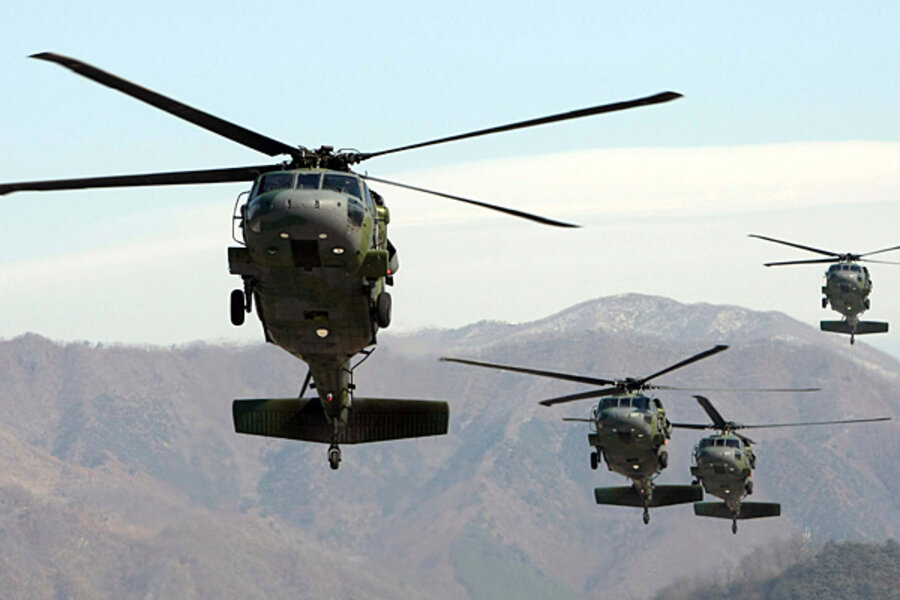Tensions flare in crossfire between South Korea and North
Loading...
| Seoul, South Korea
North Korea raised the stakes Wednesday in the fight-talk contest for advantage in negotiations with live-fire artillery exercises that once again put tensions on edge between the two Koreas.
In a risky game of punch and counterpunch, North Korean gunners opened the episode in the morning by firing off 30 rounds into the Yellow Sea off the Korean west coast, judging from the number of geysers of water reportedly kicked up in the sea where they landed. South Korea responded with as many as 100 warning shots, according to South Korean defense officials, while the South’s Defense Ministry protested in a faxed message to the North.
The contest resumed in the afternoon with the North firing another dozen or so rounds after asserting its right to stage “exercises” in waters long disputed by the two Koreas. This time, however, the South did not fire warning shots – apparently in hopes of tamping down tensions while pursuing talks on issues ranging from the North’s nuclear program to resumption of tourism.
The shootout dramatized the dangers in troubled waters while North Korea pursues a peace treaty to mark a formal ending to the Korean War that broke out nearly 60 years ago.
North Korea earlier declared the area a no-sail zone, telling ships to stay away during test-firing.
The North Korean warning suggested that the North might plan to test short-range missiles, as it has done in the past, but the firing Wednesday was limited to artillery. Unlike in previous tests, however, the shells landed close to the “northern limit line” (NLL) set by the UN Command in 1956 three years after the Korean War, below which North Korean vessels are banned.
The General Staff of the North Korea’s Korean People’s army said the firing was part of an annual drill, that it had every right to stage live-fire exercises – and may go on doing so. South Korea’s defense ministry called the artillery exercise “a grave provocation” and demanded North Korea rescind the no-sail warning.
North Korea has repeatedly repudiated the NLL, and the area was the scene of bloody shootouts in June 1999 and in June 2002 when a number of sailors on both sides were killed. In the most recent previous incident, on November 10, a North Korean vessel retreated in flames after South Korean ships fired on it when it strayed across the line.
This time there were no reports of casualties, but South Korean officials worried that the firing was a sign of a two-track strategy in which North Korea has appeared interested in negotiations but has engaged in harsh rhetoric against South Korea.
North Korea “has been blowing hot and cold,” says Wi Sung Lac, the South’s chief nuclear envoy, back from four days of talks in Washington last weekend.
North Korea accused South Korea of making “an open declaration of war” after South Korea’s defense minister said the South would have to attack first if North Korea appeared likely to stage a nuclear attack. North Korea also responded with outrage, warning of war, after learning that the South was engaged in “contingency planning” in case of the collapse of the North Korean regime.
Mr. Wi says it’s “difficult” to ascertain the North’s intentions but hopes that North Korea would soon return to six-party talks on its nuclear weapons. South Korean officials have hinted that talks on a peace treaty, long sought by North Korea to replace the Korean War armistice, might be held simultaneously with six-party talks rather than after North Korea has done away with its nuclear program.
After months of tension, South Korea has resumed shipments of aid, mostly fertilizer, to North Korea, and North and South have agreed on talks next week on easing restrictions on South Korean companies and personnel at the economic complex at Kaesong, 40 miles north of Seoul, above the line between the two Koreas. North and South Korean negotiators also are expected to open talks soon on resuming tours to the Mount Kumkang region, suspended in July 2008 after a South Korean woman was shot and killed by a North Korean soldier when she wandered outside the tourist area.
A South Korean spokesperson said Wednesday’s shelling did not endanger a South Korean vessel returning with a load of silica through nearby waters from the North Korean port of Haeju on the Yellow Sea.





